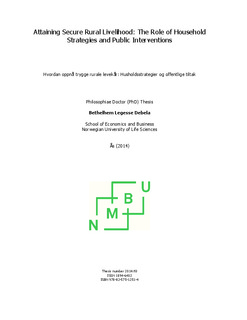| dc.contributor.advisor | Holden, Stein | |
| dc.contributor.advisor | Shively, Gerald | |
| dc.contributor.author | Debela, Bethelhem Legesse | |
| dc.date.accessioned | 2016-12-22T12:25:04Z | |
| dc.date.available | 2016-12-22T12:25:04Z | |
| dc.date.issued | 2014 | |
| dc.identifier.isbn | 978-82-575-1251-4 | |
| dc.identifier.issn | 1894-6402 | |
| dc.identifier.uri | http://hdl.handle.net/11250/2425779 | |
| dc.description.abstract | This dissertation uses survey data from Northern Ethiopia and Western Uganda to study the role of household strategies and public interventions in enabling households to attain secure rural livelihoods.
The thesis composes of four articles. Paper 1 assesses household devised strategies of using forests and diversified income sources to cope with shocks. It uses data from a forested area in Western Uganda. Findings showed that forests serve as safety nets in the face of shocks and that households diversify their income sources in response to shocks. Losses due to non-labor shocks precipitate forest extraction and higher rates of income diversification while shocks affecting labor in the households does not. Papers 2 and 3 investigate the effect of a public intervention, Ethiopia’s Productive Safety Net Program (PSNP), on household welfare. The papers use panel data from Northern Ethiopia. Paper 2 studies whether the PSNP promoted investment in livestock and children’s education. We find that the PSNP have a positive effect on livestock accumulation and children’s education, after controlling for selection bias. Participating in the program protect households from sacrificing their children’s education in response to shocks. In paper 3, we study the nutrition impact of the PSNP for children under five years. Findings indicate that the program provide short term nutritional benefit for children, especially in those households that are able to leverage underemployed female labor. Paper 4 examines differences in livestock dynamics between female- and male-headed households and factors contributing to it. Results showed that female-headed households own significantly lower livestock than maleheaded households. Lower endowment of land area, male labor and children (age 6-14) in female-headed households are the observed factors causing the difference. | nb_NO |
| dc.language.iso | eng | nb_NO |
| dc.publisher | Norwegian University of Life Sciences, Ås | |
| dc.relation.ispartofseries | PhD Thesis;2014:93 | |
| dc.title | Attaining secure rural livelihood : the role of household strategies and public interventions | nb_NO |
| dc.title.alternative | Hvordan oppnå trygge rurale levekår : husholdsstrategier og offentlige tiltak | nb_NO |
| dc.type | Doctoral thesis | nb_NO |
| dc.source.pagenumber | 180 | nb_NO |
